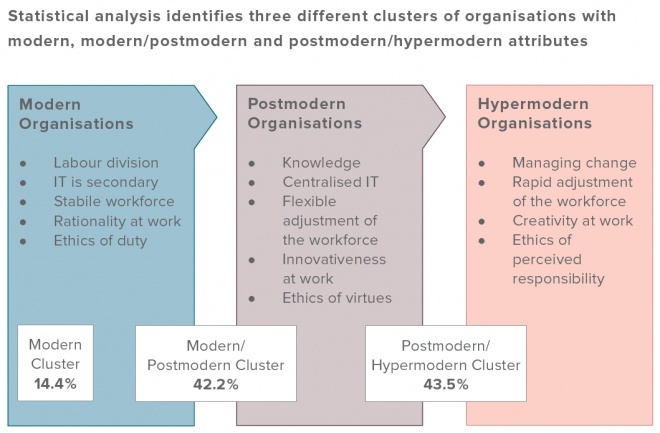
Change in overdrive is a characteristic of our modern global hypermodern culture: organisations have to adapt to these changes in order to survive.
Results from the European Communication Monitor 2017 show that European communication professionals are helping their organisations to function in a hypermodern culture.
(Photo by JOSHUA COLEMAN on Unsplash)
In today’s global society, organisations are expected to continuously reflect not only on their own behaviour but on the role they play in society at large. The modern environment organisations must operate in has been described as a hypermodern society, a successor of the modern, secular-rational society of 20th century and the individualistic self-expressive postmodern society that came into being after the cultural revolutions of the 1960s and 1970s.
A hypermodern society combines the two and accelerates the pace of change. A hypermodern society is a society in overdrive, characterised by a culture of hyper consumption, hyper change and hyper individualism. The communication function plays an important role in helping the organisation to adapt to a hypermodern society.
Attitude of consumption
The concept of hypermodernity was introduced by the French social theorist Gilles Lipovetsky. In a hypermodern culture, he wrote, an increasingly large part of life is characterised by an attitude of consumption; also, a majority of people have become turbo-consumers outside the domain of the economy. The result being not only the selling and buying of vast amounts of products and services, but also a consumer mentality in sectors that traditionally operated according to a different logic - for example health care and education.
Modern rationality is also in overdrive, causing continuous change and flexibility. Furthermore, postmodern individualisation has shifted to hyper narcissism or hyper individualism. For example, everybody is expected to behave responsibly on their own accord in all sectors of life . That is also expected of organisations: every person and every entity is expected to be responsible for its do’s and don’ts.
Paradoxes
Hypermodern culture is full of paradoxes. In fact, paradox is one of the most eye-catching aspects of hypermodernity. For example, while belief in rationality, science and technology is bigger than ever, so is criticism of scientific developments and technological applications.
A typical hypermodern organisational paradox is that organisations have to be open and flexible but at the same time should carefully manage and control their internal and external environment in order to reach their goals (for example to earn a profit and to increase employment).
Meanwhile, the management of organisations is constantly confronted with all kinds of contradicting interests and opinions, not only outside the organisation but also inside by their hypermodern employees. What’s more, an effective and responsible answer to all of these demands is expected.
Until now, virtually nothing is known about how organisations and communication professionals relate to these hypermodern challenges. However, in this year’s European Communication Monitor, communication professionals were asked for the first time about aspects of hypermodernity and how this cultural development influences their organisations and their work.
Fig. 1: Three different clusters of organisations in Europe as seen by communication professionals

www.communicationmonitor.eu / Zerfass et al. 2017 / n= 3,387 communication professionals. Hierarchical cluster analysis based on Q10 (characteristics applied to the organisation, ranging from not at all to very much) and Q 11 (importance of characteristics within the organisation’s culture, ranging from not important at all to very important) identified three different groups of respondents.
Hypermodern organisations
A vast majority of European communication professionals (71.5 per cent) see a cultural transformation towards a hyper modern culture taking place in their organisation. It is a transformation in progress: in many organisations, characteristics of the early 20th century modern and late 20th century postmodern way or organising and managing remains recognisable. Only about 14 per cent of communication professionals characterise their organisation as ‘typically modern’ with a clear labour division, a stabile work force and a rational organisation as key aspects.
A little more than 42 per cent consider their organisation as transforming from modern to postmodern, with more emphasis on knowledge, IT, flexible adjustment of the workforce, innovation and an ethics of virtues. 43.5 per cent of communication professionals say they are seeing their organisation change from a postmodern to a hypermodern organisation with characteristics such as continuous change, decentralised IT, rapid adjustments of the workforces, creativity and ethics of perceived responsibility (see figure 1 for an overview).
Figure 1: Three different clusters of organisations in Europe as seen by communication professionals
Hypermodern communication
The transition from postmodern to hypermodern culture is most perceived in communication consultancies (57.2 per cent) and private companies (51.8 per cent). Organisations with postmodern and hypermodern characteristics seem faster and better at sensing the trend towards an overarching consumer mentality. Most of them believe that it has already changed stakeholder communications, while a majority thinks that it will further change communications in the next three years.
However, while active participation in social debates can be considered a necessity in relating to hypermodern publics, only a minority of European organisations are actively engaged in public debates about contested topics in society. Organisations participate mostly in debates about ecology and climate (44.7 per cent), followed by open borders for business (36.3 per cent) and the future of Europe and the European Union (28.9 per cent). See figure 2 for an overview.
Figure 2: Participation of European organisations in societal debates

www.communicationmonitor.eu / Zerfasset al. 2017 / n = 3,387 communication professionals. Q 13: To what extent does your organisation actively communicate in the following current societal
debates? Scale 1 (Not at all) –5 (Very active). Percentages: Frequency based on scale points 4-5.Meanvalues. ** Highly significant differences (Kendall rank correlation, p ≤ 0.01).
A hypermodern culture of overdrive and paradox yields many new challenges for the communication profession. Organisations have to adapt their structure, activities and their strategic communication to cope with an ever-changing environment. Results from the European Communication Monitor show that communication professionals in Europe are aware of the changes that are taking place showing that the profession has a good starting position to help organisations surviving in hypermodern times.



